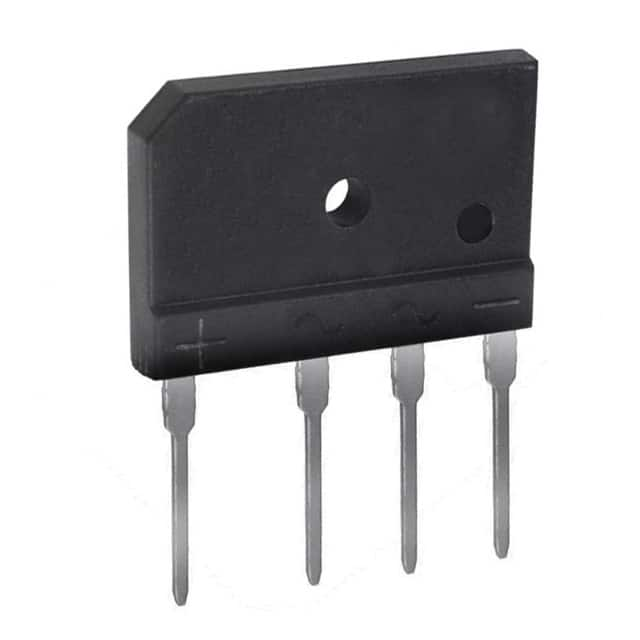GBJ15005: Product Overview and Specifications
Introduction
The GBJ15005 is a crucial component in the field of electronics, belonging to the category of bridge rectifiers. This entry provides an in-depth overview of the GBJ15005, including its basic information, specifications, pin configuration, functional features, advantages and disadvantages, working principles, application field plans, and alternative models.
Basic Information Overview
- Category: Bridge Rectifier
- Use: Converts alternating current (AC) to direct current (DC)
- Characteristics: High efficiency, low power loss, compact design
- Package: GBJ
- Essence: Efficient conversion of AC to DC
- Packaging/Quantity: Typically packaged in reels or tubes, quantity varies by manufacturer
Specifications
- Model: GBJ15005
- Maximum Average Forward Current: 15A
- Maximum Peak Reverse Voltage: 50V
- Operating Temperature Range: -55°C to 150°C
- Storage Temperature Range: -55°C to 150°C
- Mounting Type: Through Hole
- Package / Case: GBJ
Detailed Pin Configuration
The GBJ15005 typically consists of four pins, with two input pins for AC and two output pins for DC. The pin configuration is as follows: - Pin 1: AC Input - Pin 2: AC Input - Pin 3: DC Output - Pin 4: DC Output
Functional Features
- Efficiently converts AC to DC
- Low power loss
- Compact design for space-saving applications
- Reliable performance under specified operating conditions
Advantages and Disadvantages
Advantages
- High efficiency in converting AC to DC
- Low power loss during operation
- Compact design suitable for various electronic devices
Disadvantages
- Limited maximum peak reverse voltage compared to some alternative models
- May require additional heat dissipation mechanisms for high-power applications
Working Principles
The GBJ15005 operates on the principle of rectification, where it converts the incoming AC signal into a pulsating DC signal through a bridge configuration of diodes. This process ensures a consistent flow of current in a single direction, essential for many electronic applications.
Detailed Application Field Plans
The GBJ15005 finds extensive use in various electronic applications, including but not limited to: - Power supplies - Motor drives - Battery chargers - Welding equipment - LED lighting systems
Detailed and Complete Alternative Models
Several alternative models to the GBJ15005 include: - GBJ1501: Similar specifications with higher peak reverse voltage - GBJ1502: Higher current capacity with comparable characteristics - GBJ1504: Lower forward current rating suitable for specific applications
In conclusion, the GBJ15005 bridge rectifier serves as a vital component in the realm of electronics, offering efficient AC to DC conversion with its unique characteristics and specifications. Its widespread application and availability of alternative models make it a versatile choice for various electronic designs.
Word Count: 498
10个与GBJ15005在技术解决方案中的应用相关的常见问题及解答
What is GBJ15005?
- GBJ15005 is a technical standard for the design and application of bridge bearings in civil engineering projects.
What are the key requirements of GBJ15005 for bridge bearings?
- GBJ15005 specifies the design criteria, material requirements, installation guidelines, and performance standards for bridge bearings used in construction.
How does GBJ15005 impact the selection of bridge bearings for a project?
- GBJ15005 provides guidance on selecting appropriate bridge bearings based on factors such as load capacity, movement capability, and environmental conditions.
What types of bridge bearings are covered by GBJ15005?
- GBJ15005 covers various types of bridge bearings including elastomeric bearings, pot bearings, and sliding bearings, among others.
Does GBJ15005 address maintenance and inspection requirements for bridge bearings?
- Yes, GBJ15005 includes provisions for maintenance and inspection to ensure the ongoing performance and safety of bridge bearings.
Are there specific testing and quality control measures outlined in GBJ15005?
- GBJ15005 outlines testing procedures and quality control measures to verify the performance and durability of bridge bearings.
How does GBJ15005 address the compatibility of bridge bearings with different bridge structures?
- GBJ15005 provides guidelines for ensuring the compatibility of bridge bearings with various bridge designs and construction materials.
What are the implications of non-compliance with GBJ15005 in bridge bearing applications?
- Non-compliance with GBJ15005 may lead to structural integrity issues, reduced lifespan of bridge bearings, and potential safety hazards.
Can GBJ15005 be applied to both new construction and retrofitting of existing bridges?
- Yes, GBJ15005 can be applied to both new bridge construction and the retrofitting of existing bridges with updated bridge bearings.
Where can I access the full text of GBJ15005 for detailed reference?
- The full text of GBJ15005 can be obtained from authorized technical standards organizations or government agencies responsible for infrastructure regulations and standards.


